Scotch Macaskill's Wildlife Blog
IMPORTANT: Please note that from April 2009 this Blog's Web address changed as a result of a switch in the blogging platform we use. It's still an integral part of the Wildlife Pictures Online website and, we hope, will continue providing entertaining and enjoyable content in the form of wildlife images, news, views and information.
For the most recent posts, links, and other resources, please visit the new Wldlife Photography Blog.
|
Today's picture: Trio of young waterbuck males
November 2, 2005
|
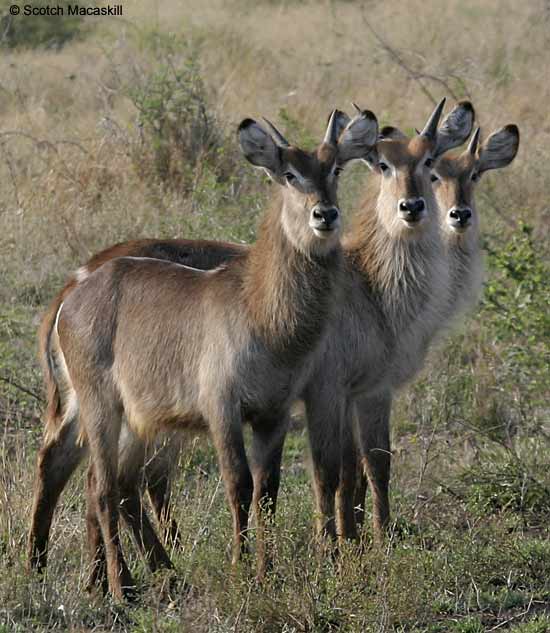
Photo Details: Bachelor herd of juvenile Waterbuck (Kobus ellipsiprymnus) Kruger National Park, South Africa.
Camera: Canon EOS Digital Rebel;
Lens: Canon 100-400mm IS zoom;
Focal Length: 250mm;
Shutter Speed: 1/200;
Aperture: f9;
ISO: 200
Further Info
Waterbuck are large, heavy antelope, males weighing 250-270kg (550-600lbs) with a shoulder height of 1.3m (4.2ft).
As the name implies, they are found mainly on floodplains and grassy areas along rivers, seldom more than 2km from open water.
Waterbuck have a coarse coat, grayish brown in color, with white throat and facial markings. The characteristic feature is the broad white
ring around the rump.
Only the males have horns. The photo above is of a small bachelor herd of juvenile males, as can be seen from the size of
their still developing horns.
Mature males on the other hand have impressive horns sweep that forward in an even curve and are heavily ridged, becoming smoother
towards the tips. The pictures below
show typical horns on a mature male (left), and the characteristic white ring around the rump (here on a mature female).
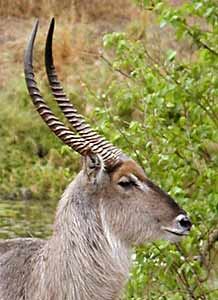
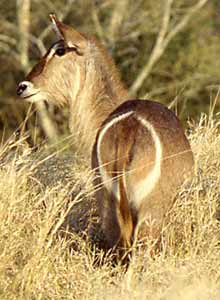
|
Today's picture: White Rhino in soft morning light
November 3, 2005
|
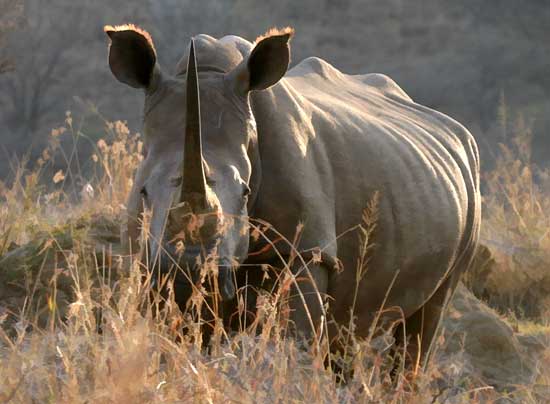
Photo Details: White Rhinoceros (Ceratotherium simum) in soft, early morning light, Weenen Nature Reserve, South Africa.
Camera: Canon EOS Digital Rebel;
Lens: Canon 100-400mm IS zoom;
Focal Length: 160mm;
Shutter Speed: 1/250;
Aperture: f5.6;
ISO: 400
More about Rhino
Two types of rhinoceros are found in southern Africa - the white rhinoceros (Ceratotherium simum) and
black rhinoceros (Diceros bicornis).
The photo above is of a female white rhino.
The names have nothing to do with colour - both white and black rhino are grey to greyish-brown. They enjoy wallowing in mud and dust, which also influences the color from day to day.
So how do you tell the difference?
The most obvious differences are:
- physical size
- shape of the mouth
The white rhino is significantly larger and, weighing around 2,000kg, is the second largest land mammal after the
African elephant. The black rhino weighs less than half - around 960kg - and is proportionally smaller.
White rhino are grazers - they eat mainly short, green grass - and have wide, square mouths that allow
efficient bulk grazing.
Black rhino on the other hand are browsers, eating almost exclusively leaves and twigs from trees and shrubs.
They have a pointed mouth with a hooked upper lip that enables them to browse selectively, while they are also able to use their molars to
take bigger bites and crunch woody or fibrous vegetation. The pictures below show a white rhino with its distinctive
square mouth (left) and a black rhino with its more pointed mouth designed for browsing.
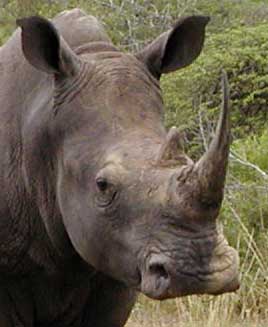
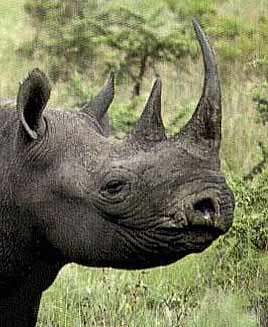 Black Rhino Pic credit: Animal Pictures Archive
Black Rhino Pic credit: Animal Pictures Archive
Black rhino numbers have fallen drastically - 96% of the population was lost to poaching in the 1970s and 80s -
and this species is now critically endangered.
In a bid to boost this dwindling population, 21 black rhino were recently released into the Zululand Rhino Reserve
in KwaZulu-Natal province, South Africa as part of the WWF/Ezemvelo KZN Wildlife Black Rhino Range Expansion Project.
Below is a photo showing one of the black rhino being released from its crate.
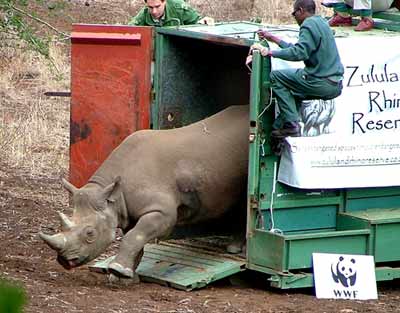
See also entry titled Bid to Boost Black Rhino Population posted on October 26, 2005 for more on this project.
Killed for their horns
Rhino, both black and white, are poached for their horns. Rhino horn is formed from keratin (the same material from which human nails and hair is formed) and the horn grows out of the skin on the nose. If removed, the horn will grow again at about 5cm a year. Sadly though, most rhino are killed before the horn is removed.
The demand for rhino horn is fuelled by two "uses":
- as a medicine or aphrodisiac in powdered form in traditional Chinese medicine
- for crafting into dagger handles in Yemen and other Middle Eastern countries
Update: Killing of rhinos for their horns is now at crisis levels with the very real possibility that rhino numbers will shortly go into terminal decline, leading to their extinction in the wild.
See Rhino Poaching Crisis for an overview of why there's been such a dramatic increase and what factors are now fuelling demand for rhino horm.
|
Elephant attacks truck, kills passenger
November 5, 2005
|
An elephant cow attacked a 3-ton truck earlier this week, ripping the cab apart before goring a woman passenger to death.
The attack took place in the Greater St Lucia Wetland Park, a World Heritage Site in KwaZulu-Natal province, South Africa.
The victim worked for Ezemvelo KZN Wildlife, the conservation body that oversees the park.
She and other staff members were driving through the park in the early evening when they came across a resident herd of about 24 elephants.
They switched off the vehicle lights to allow the elephants to disperse, before proceeding on their way. However, they again encountered the elephants, at which stage the attack took place.
Jeff Gaisford, a spokesman for KZN Wildlife, explained that, in attacking the vehicle, the elephant was dealing with a perceived threat to the herd.
|
Need help in choosing the right digital SLR camera?
November 5, 2005
|
If you're thinking of buying a digital SLR (single lens reflex) camera and unsure which model to choose, I've found an excellent website that will help you make up your mind.
The Digital SLR Guide is not a tech-heavy site that will boggle your mind with complex data. Instead, it sets out four simple steps to follow that will ultimately save you time, money, and buyer's remorse.
Digital SLR jargon is clearly explained, so you'll know what the salesman is talking about when he tries to sell you more than you need.
You may also be surprised by the top-rated SLRs, based on user opionons - it's not what you'd expect.
Even if you already own a digital SLR, the site offers plenty of useful information and is definintely worth visiting and adding to your favorites for future reference.
|
Today's picture: Elegantly Curvaceous Swan
November 5, 2005
|
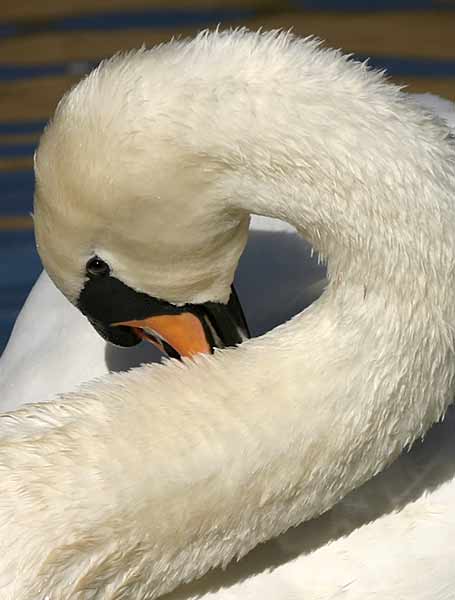
Photo Details: Swan (Cygnus olor) preening itself, local waters, KwaZulu-Natal, South Africa.
Camera: Canon EOS Digital Rebel;
Lens: Canon 80-200 F2.8 zoom;
Focal Length: 175mm;
Shutter Speed: 1/000;
Aperture: f5.6;
ISO: 100
|
Today's picture: Golden Lioness
November 6, 2005
|
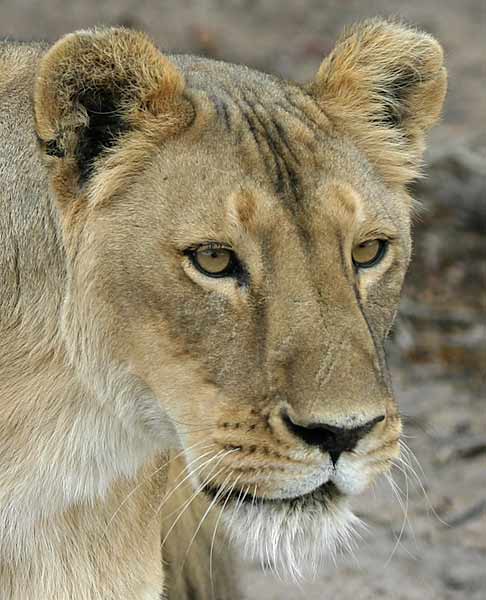
Photo Details: Lioness (Panthera leo) close-up, Endangered Species Centre,
Kapama Game Reserve, South Africa.
Camera: Canon EOS Digital Rebel;
Lens: Canon EF 80-200 F/2.8 zoom;
Focal Length: 115mm;
Shutter Speed: 1/1000;
Aperture: f4;
ISO: 200.
|
Today's picture: Baobab Tree, Botswana
November 8, 2005
|
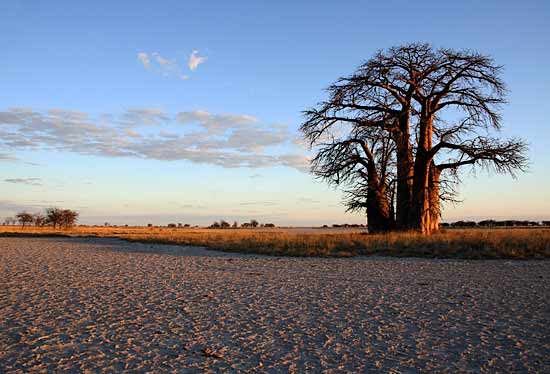
Photo Details: Baobab Tree (Adansonia digitata) in late afternoon light on Sua Pan near Nata, Botswana.
Camera: Canon EOS 350D;
Lens: Canon 18-55 zoom;
Focal Length: 18mm;
Shutter Speed: 1/500;
Aperture: f5.6;
ISO: 400
More Info:
Sua Pan forms part of the Makgadikgadi Pans, the vast network of salt pans that cover 12,000 sq km of Botswana.
These are some of the largest salt pans in the world and once deep inside them, there are few landmarks to guide you.
The desolate landscape is occasionally broken by small "islands" of grass and trees, as in the photo above.
After the summer rains, the pans come to life, providing sustenance to migrating herds of zebra and wildebeest. If there is sufficient water, they also offer a temporary home to thousands of flamingoes.
|
Today's picture: Klipspringer and Impala
November 10, 2005
|
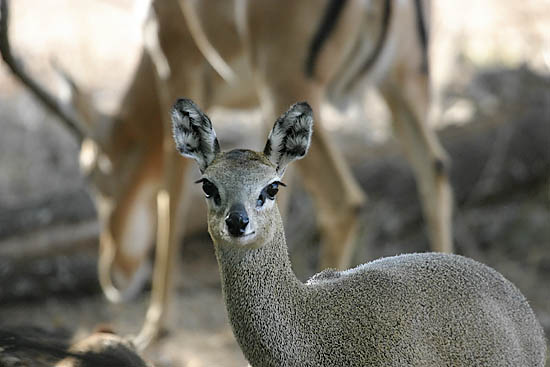
Photo Details: Klipspringer (Oreotragus oreotragus) female with Impala ram grazing in the background, Mashatu Game Reserve, Botswana.
Camera: Canon EOS Digital Rebel;
Lens: Canon 100-400mm IS zoom;
Focal Length: 400mm;
Shutter Speed: 1/200;
Aperture: f5.6;
ISO: 800
|
Today's picture: Crocodile Jaws
November 15, 2005
|
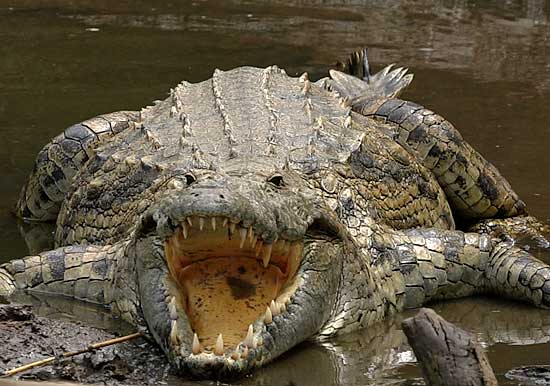
Photo Details: Nile Crocodile (Crocodylus niloticus) Ndumo Game Reserve, KwaZulu-Natal, South Africa.
Camera: Canon EOS Digital Rebel;
Lens: Canon EF 100-400mm IS zoom;
Focal Length: 275mm;
Shutter Speed: 1/640;
Aperture: f8;
ISO: 400
|
Today's picture: Blackheaded Heron
November 16, 2005
|
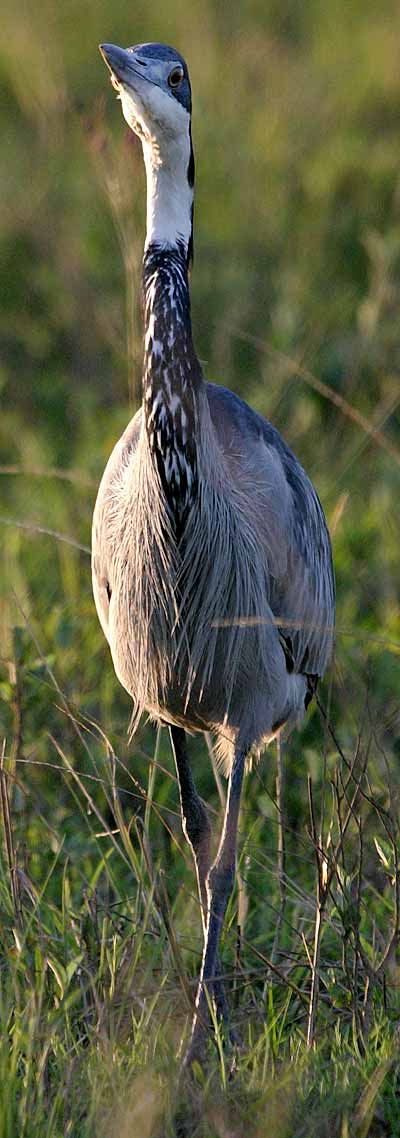
Photo Details: Blackheaded Heron (Ardea melanocephala) raises its head briefly between foraging for insects, late afternoon, Tala Private Game Reserve, KZN, South Africa.
Camera: Canon EOS Digital Rebel;
Lens: Canon EF 100-400mm IS zoom;
Focal Length: 400mm;
Shutter Speed: 1/400;
Aperture: f7.1;
ISO: 800
|
Today's picture: Zebra Portrait
November 17, 2005
|
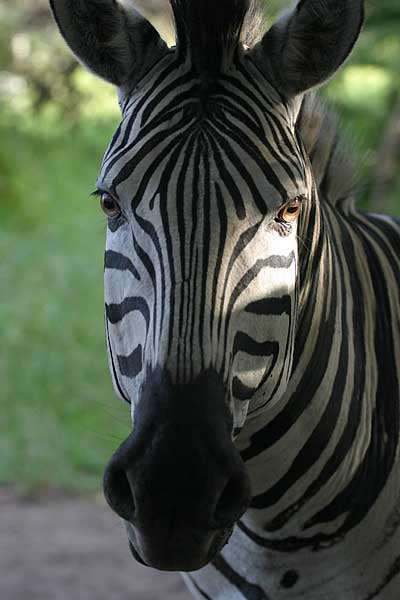
Photo Details: Burchell's Zebra (Equus burchelli) close-up, photographed in the Kenneth Stainbank Nature Reserve, KZN, South Africa.
Camera: Canon EOS Digital Rebel;
Lens: Canon EF 80-200 F/2.8 zoom;
Focal Length: 80mm;
Shutter Speed: 1/200;
Aperture: f4;
ISO: 400
|
Today's Picture: Baby Baboon
November 22, 2005
|
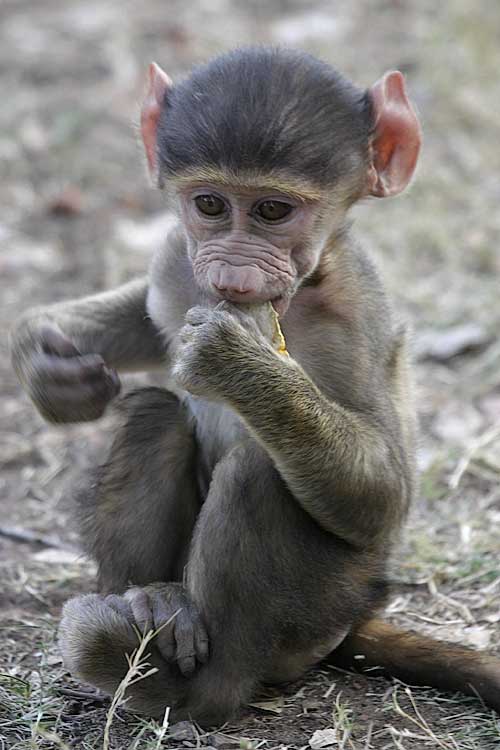
Photo Details: Baby Chacma baboon sucking on dried orange peel, Mosi-Oa-Tunya Park, Victoria Falls, Zambia.
Camera: Canon EOS Digital Rebel;
Lens:Canon EF 100-400 IS zoom;
Focal Length: 320mm;
Shutter Speed: 1/125;
Aperture: f5.6;
ISO: 400
More Info:
This photograph is viewed more than any other single image on my website - probably because people find it when doing a search for "baby baboon" on Google Image search.
Now Available: Wildlife Photo Packs - see examples below. Each Photo Pack contains 15 high quality images that are ideal for art reference,
websites, school and college assignments, crafts, and just about any creative projects. Go to Wildlife Shopping if you'd like to find out more.
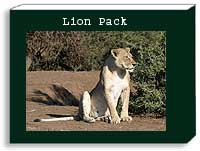
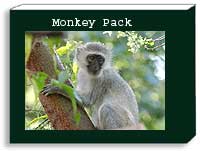
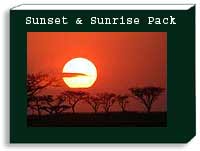
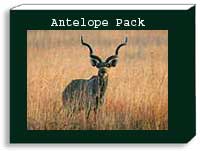
|
Today's Picture: Buffalo Bull, Close-up
November 23, 2005
|
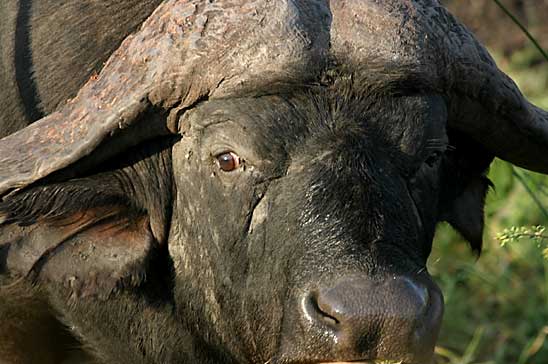
Photo Details: Buffalo Bull (Syncerus caffer), close-up, Kruger National Park, South Africa.
Camera: Canon EOS Digital Rebel;
Lens:Canon EF 100-400 IS zoom;
Focal Length: 400mm;
Shutter Speed: 1/250;
Aperture: f7.1;
ISO: 400
|
National Geo's "WildCam Africa" Ready to Roll Again
November 24, 2005
|
In September this year, National Geographic set up a satellite link to a camera overlooking a waterhole in a remote corner of Botswana. In the ensuing weeks, wildlife enthusiasts around the world started watching the live video feed from Mashatu Game Reserve in Botswana's Tuli Block.
Some watched and went away; others became enthralled with this fascinating insight into the lives of wild animals.
Not only could you hear the sounds of birds and animals from the waterhole, but you could also watch the nightlife as the camera beamed live action 24 hours a day.
"Pete's Pond", as the waterhole is known, soon generated a dedicated group of addicts, their regular lives thrown into upheavel by the difference in time zones. Prime viewing time at Pete's Pond can mean 3am or 7pm - depending on your location in relation to Botswana.
One of these groups of "Ponders", as they have become known, has an amazingly active news group where members have become expert at grabbing screen shots of the wildlife, which they post to the group. There's even comprehensive data about what's been sighted and tips on identifying the wildlife.
As a "lurker" to this Yahoo group, I've been amazed at the dedication and passion shown by the members. It's also been a humbling experience.
I've been lucky enough to sit in the "hide" on my own at Pete's Pond, where the WildCam is set up, watching and photographing the visitors coming to drink, wallow and frolick in the muddy water. It's never been a big deal, mainly because you see a lot more when out on a game drive in Mashatu, particularly as the vehicle drivers are in radio contact, so tell each other when they come across sought-after wildlife like lions or leopards.
Now that I have a better understanding of how much the WildCam has meant to folk in city apartments, many of whom are unlikely to visit Botswana - or Africa - future trips to game reserves will never be the same. Wildlife sightings that I took for granted will be viewed with fresh eyes, looked at and appreciated from the perspective of a "Ponder" who would be enthralled by similar sights beamed to his or her computer screen from thousands of miles away.
But the past few weeks have been tough for Ponders, ever since the WildCam was knocked out by a storm. It took ingenuity and sophisticated technology to set up the cam in the first place, so spare parts are not available down the road, specially in Botswana or neighboring South Africa.
Now, at last, there's good news - according to the National Geo WildCam site, the spares have arrived and the cam is scheduled to be "up and running by Saturday morning."
If you've never watched the WildCam before, now's a good time to start as it's only there till 8th December. And for the dedicated enthusiasts who've been waiting patiently, may all your old favorites return, plus many that you've never seen before.
See the latest news about Pete's Pond Wildcam
|
Today's Picture: Black-backed Jackal
November 24, 2005
|
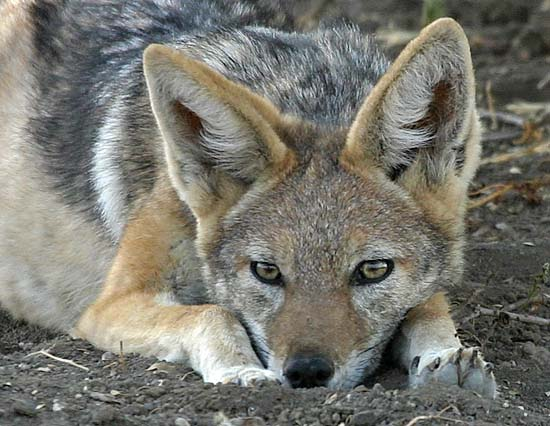
Photo Details: Black-backed Jackal (Canis mesomelas), lying under shady bush, Mashatu Game Reserve, Botswana.
Camera: Canon EOS Digital Rebel;
Lens:Canon 100-400 IS zoom;
Focal Length: 400mm;
Shutter Speed: 1/640;
Aperture: f6.3;
ISO: 400
|
Today's Picture: Yellow-billed Stork
November 26, 2005
|
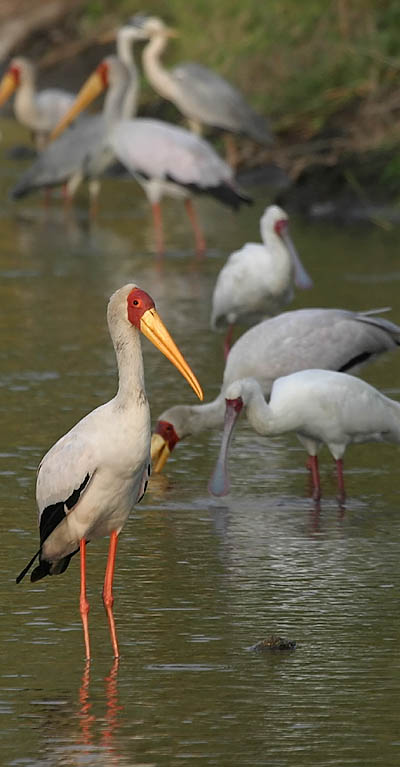
Photo Details: Yellowbilled-stork (Mycteria ibis) standing among a variety of wading birds fishing in shallows of river, Kruger National Park, South Africa.
Camera: Canon EOS Digital Rebel;
Lens:Canon 100-400 IS zoom;
Focal Length: 400mm;
Shutter Speed: 1/320;
Aperture: f7.1;
ISO: 400
More Info:
It was early morning in the Kruger National Park, at the crossing to a small river, that we came across a fascinating array of birds wading in the water.
The river had stopped running, leaving only a shallow pool in which small fish were trapped, providing a ready source of food for the storks, spoonbills, herons, and egrets. Of these, the Yellowbilled Storks were most prominent.
|
Today's Picture: Eye of the Rhino
November 29, 2005
|
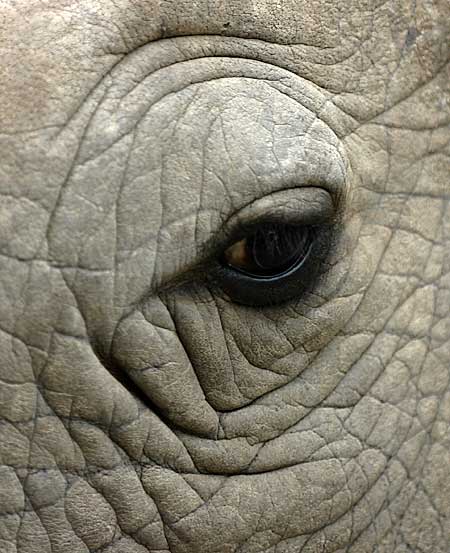
Photo Details: Close up of White Rhino (Ceratotherium simum) showing its
eye and surrounding hide, Endangered Species Centre, Kapama Game Reserve, South Africa.
Camera: Canon EOS Digital Rebel;
Lens: Canon EF 80-200 F/2.8 zoom;
Focal Length: 200mm;
Shutter Speed: 1/640;
Aperture: f2.8;
ISO: 200
Please Note: Pictures
displayed on this blog are copyright protected. View them online, enjoy them, but kindly do not use
them for anything else. Should you wish to purchase an image or require clarification on use,
please contact me.
|
| |
| Back to top of page
|
|
Previous Entries
By Month
By Category
My Original Blog
2005 Entries
2004 Entries
2003 Entries
Who Am I?
Brief Bio
|






 Black Rhino Pic credit:
Black Rhino Pic credit: 















